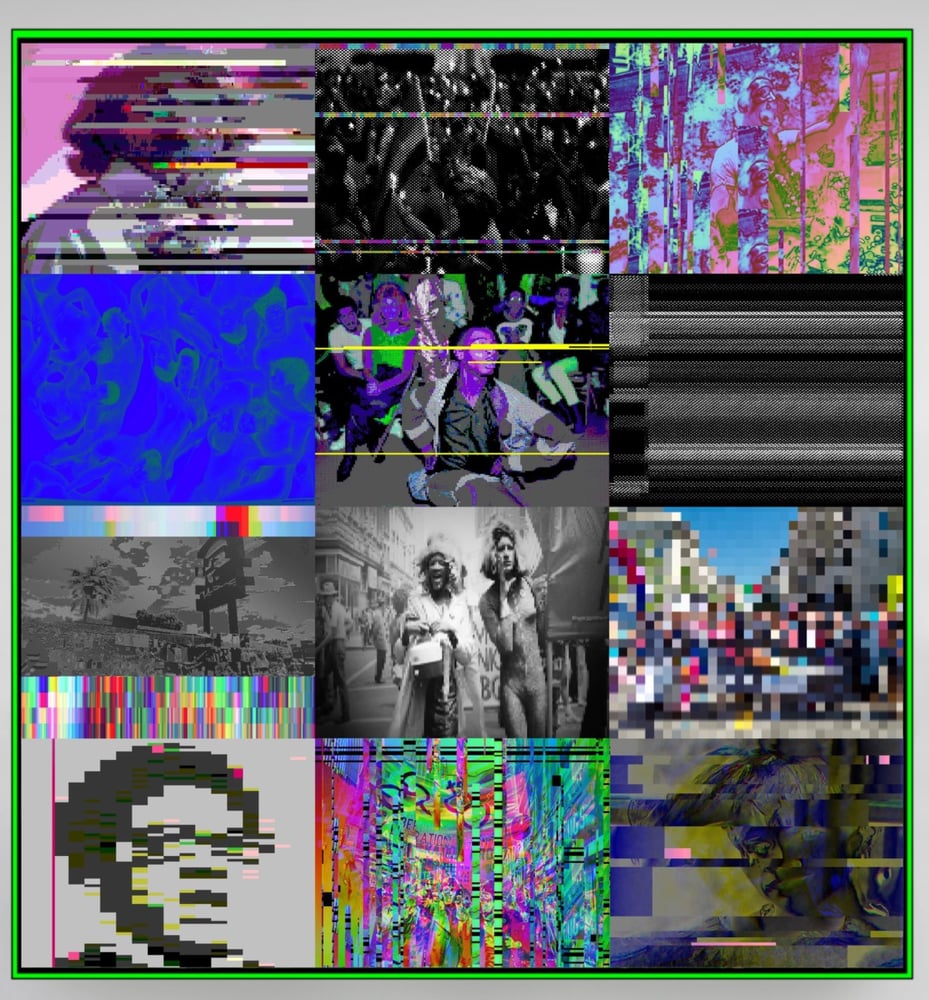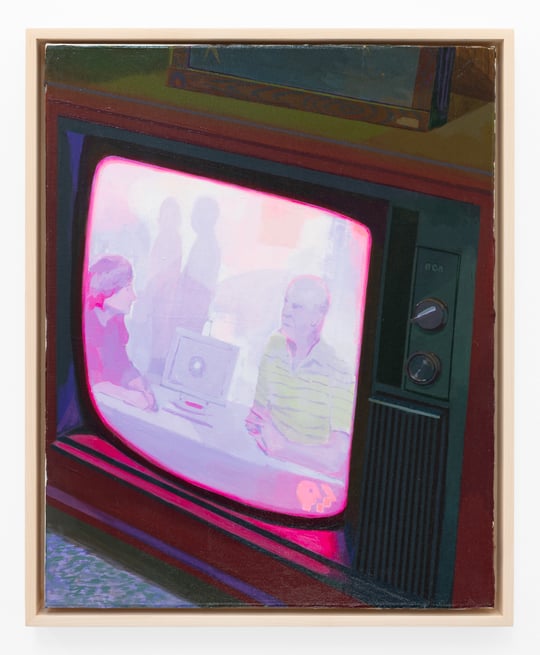
In his GRID series (2021–ongoing), Cuban-born and Miami-based artist Ricardo E. Zulueta corrupts what we understand to be the clarifying logic of the grid as a structuring formation. A grid is a network that breaks down a plane or a field—be it topographic, political, digital, or other—into more basic, comprehensible units; it helps us to better grasp a bigger picture, map coordinates, plot a course. However, in Zulueta’s body of work, the artist deploys the grid as a device of disorientation, bringing images together in a practice that testifies to the turbulence of contemporaneity.
Zulueta’s process mirrors the ways people today traffic and consume information; he compiles images non-hierarchically from a multitude of online sources. Relating to the activist causes that define the present moment, the archive he assembles is illustrative of immigration crises, rising sea levels, queer activisms, and pervasive state violence. These images are organized—at times thematically, at times not—in gridded formations that evoke the layouts of social media feeds, image search results, and news and information platforms. The overwhelming proliferation of visual information in these works nods to the sublime nature of big data.
Rather than present these images as they are sourced at face value, Zulueta processes them through a custom-coded software that renders randomly produced glitches across them. In a sense, he hacks the logic of these images and our expectations for their consumption, at times obscuring their subject matters beyond legibility. The resulting effect is a compilation of images that have been deconstructed and adulterated by the artist’s malware in a method that generates aesthetically striking productive failures. They could be said to be infected, altered at their source code in the way viral entities—COVID-19, HIV, Trojan horses, popular memes—invade their carriers.1 By destabilizing how one might expect to view and understand these images, Zulueta effectively leads viewers to confront the issues exemplified within each work through a kind of computerized interface that de- and re-contextualizes their relationships to timely social causes.

GRID 1 (untitled, rising) (2021), a matrix of twelve images arranged in a formation of three columns and four rows, presents corrupted depictions of current and impending anthropogenic climate catastrophes. In one glitched black-and-white image, a car appears to be submerged in floodwaters; another depicts an oceanic storm surging violently, causing waves to reach threatening heights. In a highly pixelated color image, a group of people lounge on a sandy beach, barely discernible. In yet another, where yellow, magenta, and cyan color channels split apart, viewers can make out the cranes and scaffolding of coastal development, a building being erected at sea level. Together, the gridded images create an impression of our collective environmental realities and the subsequent futures—crumbling infrastructures, mass destruction, and displaced populations—we might face as a result of climate change. The disjointed and zoomed-out view of GRID 1 (untitled, rising) is ultimately difficult to reconcile and fully comprehend. Instead, it brings into focus our own inability to filter through the disarray and noise obscuring our capacity to process, consume, and internalize data from myriad and, at times, competing sources.
In a related work, Rising Glitch Levels (2021), Zulueta expands the lexicon of the GRID series into a digital video in which a sequence of images quake, sway, and undulate through constant glitch transformations—their movements are suggestive of unfolding seismic cataclysms. As in GRID 1 (untitled, rising), the cycling on-screen imagery portrays both built and natural environments and alludes to the threats that human-induced climate change pose to our familiar systems and infrastructures. The glitches unsettle and reimagine these landscapes—which are also cultural, economic, and political ones—as disintegrating fields in a procedurally-generated spiral of collapse. In her 2019 book High-Tech Trash: Glitch, Noise, and Aesthetic Failure, Carolyn L. Kane argues that “glitch aesthetics . . . [provide] us with a visual language derivative of, and suited for, the specific contours of the techno logically mediated present.”2 Their interruptions to the imaginary of a well-ordered world reflect—and amplify—the metaphorical fissures and disruptions already cracking along the surface. The glitch, as employed by Zulueta, consequently functions as an alternative to the speculative projections—circulated in charts, graphics, visualizations—of futures derailing as a consequence of the conflicts and denials of the present.
Other works in Zulueta’s GRID series address the intersectional identities that the artist inhabits. In so doing he centers anxieties around the status of queer, immigrant, and other historically marginalized groups in light of their systemic mistreatment and in the wake of an uncertain and potentially ominous future. GRID 2 (untitled, crossing) (2021) addresses the politicization of border crossings through digitally corrupted images of asylum seekers, border walls, and armed border patrol agents. The work refers to the influx of Latin American immigration to the United States—much of it the result of imperialist U.S. foreign policy throughout the twentieth century, which instigated regime changes, occupations, mounting violence, and economic instability. These glitched imageries invite reflection on the United States’s broad response in more recent years to immigration considering the country’s historic complicity.

GRID 3 (untitled, revising) (2021) brings to the fore the artist’s queer identity with pixelated images of the activists Sylvia Rivera, Marsha P. Johnson, and Audre Lorde; depictions of intimacy and protest; and photos that memorialize the violence faced by queer communities during the 1969 Stonewall Uprising and the Pulse nightclub shooting of 2016. The vivid and colorful irregularities of the photos point towards the commercial practice of “rainbow-washing” this important history to make it more widely palatable. Meanwhile GRID 4 (untitled, resisting) (2021) exuberantly illustrates what appears to be the signs of a crumbling civilization. The piece depicts a perfect storm of the catastrophes that might lead to societal collapse: a highly distorted image of the Supreme Court Building is presented among the colorful, swirling vortex of a hurricane, the stark image of a lone melting glacier, photos of protest, and fully abstracted grey fields of nothingness. This final ruination of the image’s subject matter into abstraction nods to the future ruins that would be left in the aftermath of possible calamities. Further it reflects the empty static that remain of today’s sensationalist news cycle and rampant proliferation of images.
The broad reach of communications and imaging technologies envisions and contextualizes the world as we know it, often translated through the messaging of corporate media. Zulueta’s adulteration of these images degrades the encoded messages that we associate with mainstream media consumption, inviting a new kind of looking through a broken view. Yet, this gaze seems more honest in its depiction of a world in need of, or perhaps beyond, repair. The merging of our embodied experiences with Zulueta’s machinic vision provides us with a technologically derived lens and armature for approaching global instability and disorder.
In “A Cyborg Manifesto” (1985), Donna J. Haraway speaks of the cyborg as a catalyst for new ways of think-ing about gender, sexuality, and politics. She writes:
Cyborg politics are the struggle for language and the struggle against perfect communication, against the code that translates all meaning perfectly . . . cyborg politics insist on noise and advocate pollution, rejoicing in the illegitimate fusions of animal and machine.3
Zulueta’s grids express the imperfect, noisy, and polluted communication of the cyborgian gaze, highlighting the ambiguation of the image as a tool for destabilizing accelerationist frameworks. The cyborgian gaze does not accept what’s presented at face value; rather, it imagines the coded meanings that might become embedded within its abstractions of color, pixelization, and static. In this way, the gaze acts as a queering lens translated through the language of technology.

The imperfect communication of imperfect images offers radical strategies to, in the words of Legacy Russell, “reboot and rebuild” the world by way of its disruption—to embrace a visual poetics of failure.4 In her 2020 book Glitch Feminism: A Manifesto, Russell advocates for the application of the composite and systematic failings of the glitch—its imperfections— as a mode of subversion, liberation, and survival.
They urge readers to become glitch, to “embody the ecstatic and catastrophic error” and thereby “[build] new worlds . . . rearrange and repurpose by any means necessary, rendering what rises from this rebirth unrecognizable from the violence of its original.”5 The adoption of the cyborgian gaze functions similarly. Turning one’s vision towards the multi-hyphenate calamities that loom large over the present serves to distort a normative image of the world in favor of a mobilizing perspective that poses new questions, provides new answers, or reframes the conversation entirely. Returning to Kane: “An aesthetic of failure may be our most viable option for accepting the realities of the present and a prerequisite for sustained change.”6
The merging of our embodied experiences with Zulueta’s machinic vision provides us with a technologically derived lens and armature for approaching global instability and disorder.
And back to Haraway, who conceives of the cyborgian as a dual condition that reflects both “a grid of control on the planet”—a violent, chauvinist, technological control—and a flexible framework of “permanently partial . . . and contradictory” positions.7 Zulueta’s GRID series approaches the technologically mutated image as a means of re-envisioning those structures that grip our social, economic, political, and environmental circumstances. In this way, the grid becomes a stage of unstable inputs that can be translated into more manageable outputs. Taken together, these curated and edited works chart a discursive mapping that aims to dismantle binary worldviews.
Localized within the contexts of the artist’s home in South Florida and the state overall, these grid works cast the cyborgian gaze on recent legislation—the so-called Stop WOKE Act (House Bill 7) and “Don’t Say Gay” bill (HB 1557)—that limits discussions of race, gender, and sexuality in the classroom. Bringing it closer to home, as Miami is threatened by the influx of Big Tech from the north, advancing water levels from the south and east, fires that blaze in the Everglades out west, and statewide legislation that curbs queer representation, the cyborgian gaze equips us with an aesthetic framework to help recognize the rising cultural, economic, environmental, and political tides that threaten to inundate us. If allowed to swell, what would these new conditions engender? The eradication of what we know and hold dear is what remains at stake, and the cyborgian gaze might offer new methods for halting, postponing, or coming to terms with those potentialities. Zulueta’s glitching of the grid, by extension, proposes that the technologically utopian impulse of the digital environment—with its aspirations of non-hierarchical, democratic, decentralized spaces of free expression—can, as a liberating framework of futurity, be translated into new ways of envisioning our lived realities.

[1] Academic Jack Halberstam introduced the concept of failure as a productive and generative framework of existence. See Jack Halberstam, The Queer Art of Failure (Durham, N.C.: Duke University Press, 2011).
[2] Carolyn L. Kane, High-Tech Trash: Glitch, Noise, and Aesthetic Failure (Oakland, Calif.: University of California Press, 2019), 122.
[3] Donna J. Haraway, “A Cyborg Manifesto: Science, Technology, and Socialist Feminism in the Late Twentieth Century,” in Manifestly Haraway (Minneapolis: University of Minnesota Press, 2016), 57.
[4] Legacy Russell, Glitch Feminism: A Manifesto (London: Verso Books, 2020), 149.
[5] Russell, Glitch Feminism, 149–52.
[6] Kane, High-Tech Trash, 24.
[7] Haraway, “A Cyborg Manifesto,” 15.




